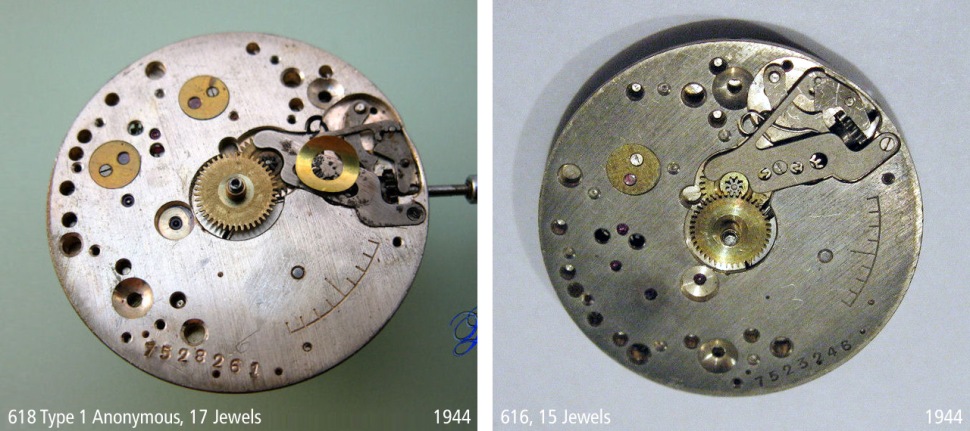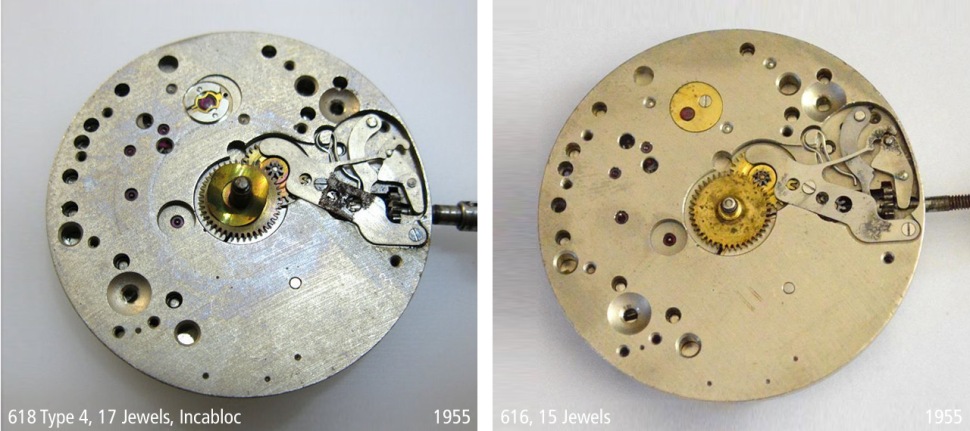A Panerai 3646 Type D with case number 260818 is being offered on several platforms. This watch entered the market only a few month ago in April 2016 after it was auctioned by Auktionshaus Eppli in Germany. The watch was orignally equipped with a brass dial but the new owner replaced the brass dial with a California dial for cosmetical reasons.
The watch was sold for € 80.900 (Euro) at the Eppli auction in April 2016, a very high price for a watch with brass dial. The new owner is now asking € 115.000 (Euro) for the whole set, including the replaced brass dial.
This watch bears a few surprises. The extraordinary way how the dial was installed sparked a fascinating forensic trip through the history of the brand.

.
Provenance
According to the present owner, this watch was brought to Auktionshaus Eppli by the widow of the original owner, a former Nazi Kampfschwimmer from Baden-Baden in Germany.
The watch is being offered with a book and the picture of the former owner and “Kampfschwimmer” Karl Heck.
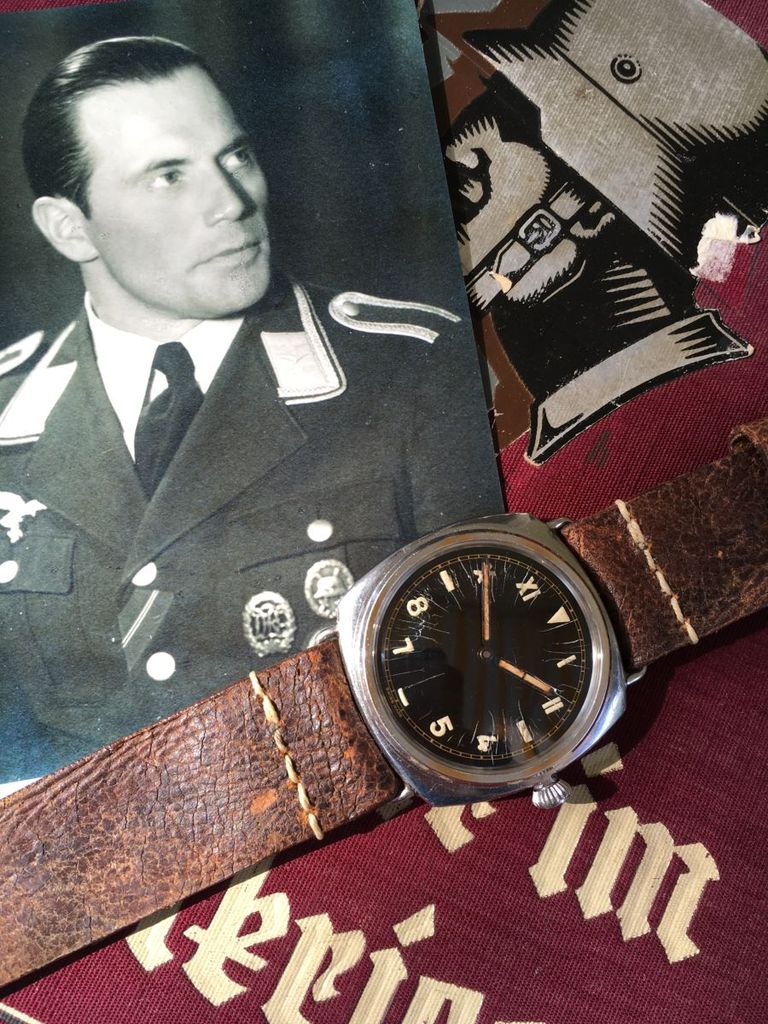
.
An interesting observation is that the uniform worn in the picture belongs to the Luftwaffe (German Airforce). Two badges can be seen on his chest. The one on the left is the “Deutsches Reichssportabzeichen” (DRL= Deutsche Reichauszeichnung für Leibesübungen), awarded for passing five specific tests in sports. The other badge on the right is the “Verwundetenabzeichen”, awarded to soldiers who have been wounded in battle.
.
The dial swap
As mentioned above this watch came originally with a brass dial. Commonly, brass dials are not very sought-after, probably due to their fuzzy look.

.
The outside of the case back bears no engravings.

.
The new owner sent the watch immediately for a service and had the brass dial replaced with a NOS (New Old Stock) California dial.

.
The full disclosure of the dial swap is exemplary! The watch is listed with a vast amount of pictures which show almost every detail. Something that immediately caught my eye were two tiny screws at 6 and 12 on the brass dial.
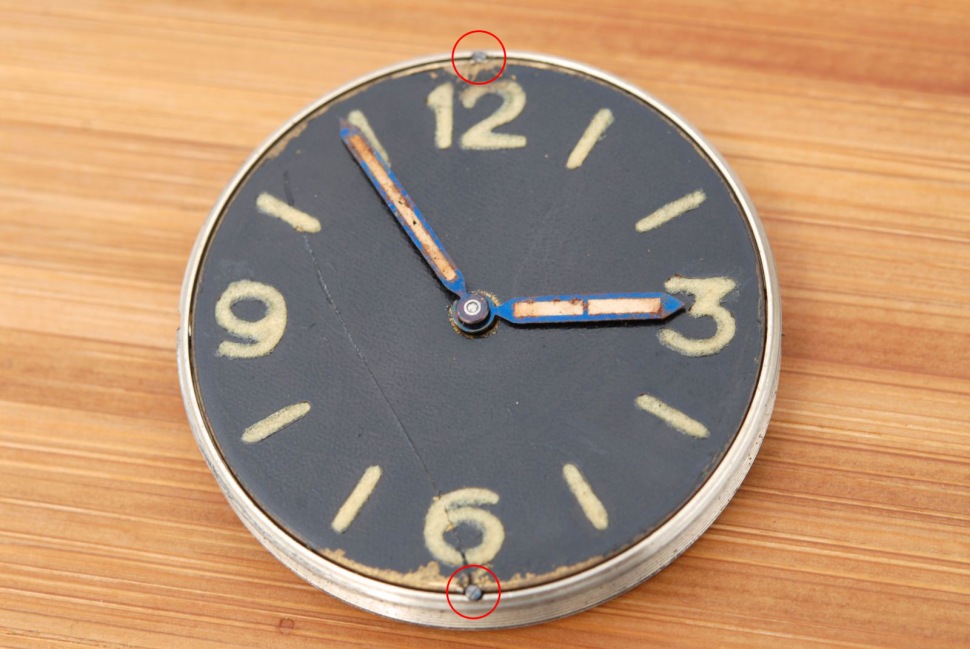
.
I inquired with the owner whether the brass dial had soldered dial feet or not and he provided an additional picture showing the back of the brass dial. The dial has no dial feet and there are no traces that feet have ever been soldered to the brass disc.

.
According to the watchmaker who serviced the watch, the two tiny screws at 6 and 12 were screwed into the movement retaining ring in order to hold the dial firmly. No traces of glue were found.
This information was extremely precious as I came across a few California dials which had similar slots at 6 and 12.
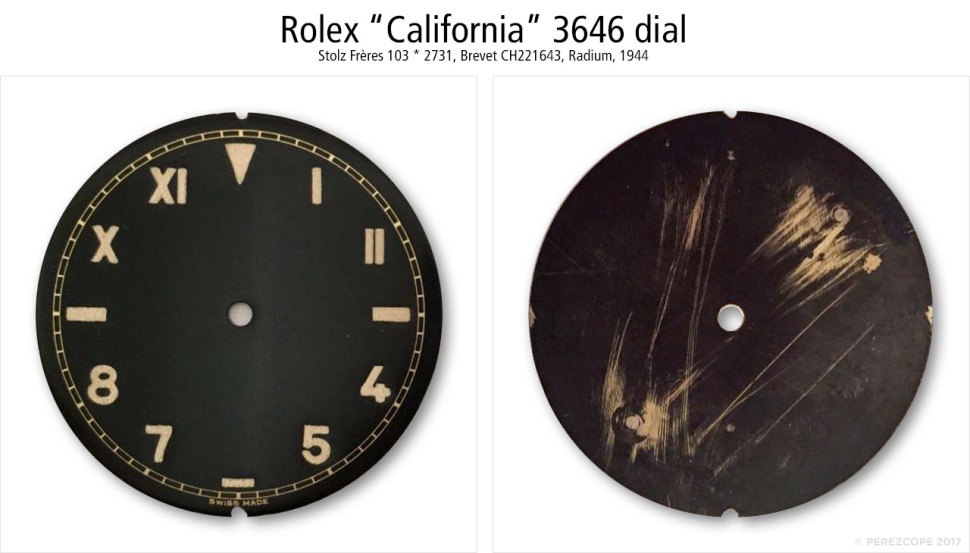
.
As you can see, this California dial has no dial feet either. They were obviously removed.
Here is another California dial with removed dial feet and slots at 6 and 12. The marks around the removed dial feet indicate that they were removed in haste and with a machine. A very brutal way, from a horological point of view.

.
There are several other 3646 with the very same dial “construction”.

.
The interesting thing is that there are brass dials as well as California dials with these slots.
The following watch, 260739, has the same construction. The provenance of this watch is quite interesting as apparently it was given to a British soldier of the bomb disposal unit by a German prisoner of war in Italy in 1944.
> Bonhams Lot 357, Rolex 3646, June 2013
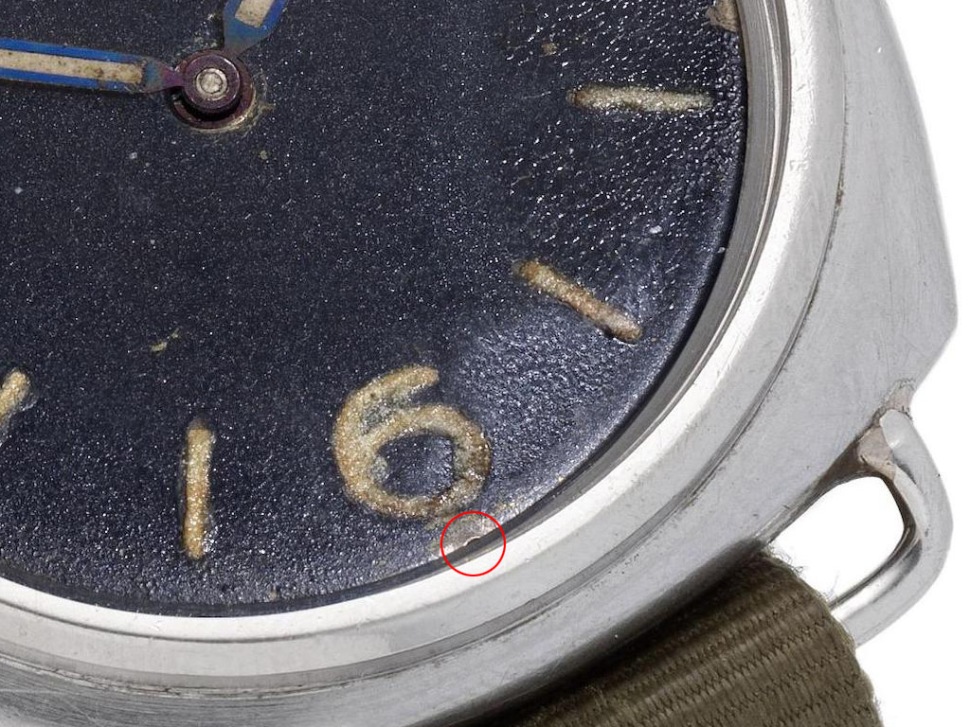
.
The next picture shows the movement rings and dials of three different 3646. The one on the right is from case number 260726. This watch is quite interesting as it features the dial of a Ref. 6154 which did not deteriorate in the same way as the usual dials.
Read more: Story of the 3646 with case number 260726
However, the movement ring of this watch has distinctive marks at 6 and 12. These holes could have been used to attach a brass dial as described above.
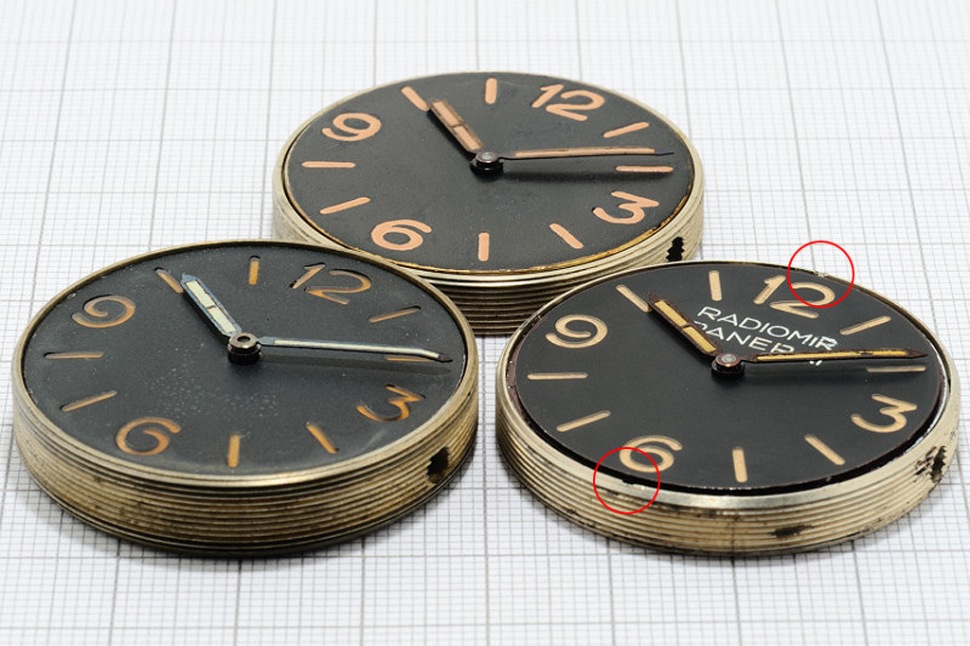
.
The movement ring in the center is also from a watch with brass dial. It belongs to a later watch of the Type E group with case number 261084. Neither the dial nor the ring have any marks at 6 and 12. There are several watches with brass dials that have regular dial feet.
However, if we compare the back of California dials with removed dial feet and those with intact feet, we can see the feet were not soldered at the same place. They also have different reference numbers: 103 * 2731 vs. 103 * 2802.

.
Dials with removed feet (103 * 2731) had the feet originally soldered in a pocket watch configuration. This is a very important fact. Those dials would have looked like this when installed in a watch.

.
Now it becomes pretty clear what happened. Rolex ordered a number of California dials for Cortebert Cal. 618 without pointing out that the dials were going to be installed in wrist watches.
Having in mind that the Cortebert Cal. 618 was pocket watch movement, Stern Frères produced the dials in typical pocket watch configuation with the crown at 12. Cal. 618 movements in Ref. 3646, however, were installed to have the crown at 3. This important detail was obviously missed. As a result, the watches would have had the 12 hour marker at 3.
In consequence and probably to salvage the dials, the dial feet were removed and 2 slots were cut out at 6 and 12 to fix the dial with tiny screws to the movement ring. This was without doubt a quick and dirty solution, but it looks like there was no time to wait for a proper dial batch.
Later California dials of reference number 103 * 2802 were flawless.
Read more about dials: Vintage Panerai – A dial taxonomy
.
The movement
This watch is powered by what appears to be a typical Rolex 618 Type 1b. The owner also provided pictures showing the serial number.

.
The number is quite surprising, as so far all, movements within this range are “Anonymous”, without Rolex engravings. There is another detail that marks an absolute exception from all other movements made by Cortebert during this period. On the right side of the movement there is a partial minute track for testing purposes.

.
The following comparison makes clear that Cal. 616/618 movements made by Cortebert have the same marks within the same serial range. Cortebert changed the test track slightly after serial number 7.521.000, placing it further inside.
This find does not automatically mean that there is something wrong with this watch, en contraire, it is an interesting curiosity and makes this a unique movement. This movement looks perfectly fine!
The initial Cal. 616/618 had no test track at all. The first Rolex 618 Type 1a used in 3646 Type A and B were plain as well.
.
The first marks appeared around 1942 and serial number 7.515.000. Rolex 618 Type 1a movements used in 3646 Type C watches typically have this type of test track.
.
The same style was still in use in Rolex 618 Type 1b movements for typical 3646 Type D watches.
.
Around serial number 7.521.000 the test track was slightly repositioned closer to the center of the movement.
.
The next pictures shows the dial side of a Rolex 618 Type 4 compared to a historically corresponding Cortebert 616. These movement have neither a serial number nor a test track.
.
Read more: Movements used in vintage Panerai watches
.
Thoughts
To me this watch is fascinating, especially due to the way the “original” brass dial was installed. I am not a big fan of brass dials myself, so I can understand the owner for swapping the dial for a more elegant California dial. Ultimately, this is how these watches were delivered to G. Panerai e Figlio. As long as the replacement is openly communicated everything is fine.
However, I assume the NOS California dial has dial feet. A better solution would be to source a California dial with removed feet and reference number 103 * 2731. This would be the ultimate “restoration to factory settings”.
Brass dials were probably made by Arturo Junghans SA in Venice, without any involvement by Panerai. The Panerai workshops were raided by the Nazis before Florence was liberated by the Allies in August 1944. The stolen goods were then shipped to Arturo Junghans in Venice, very close to the German Kampfschwimmer training facility on the island of San Giorgio in Alga.
The luminosity of California was probably not strong enough in the eyes of German Kampfschwimmers. Arturo Junghans installed the first brass dials in the very same way as the watches had been delivered, without dial feet and screws at 6 & 12..
Read more about Kampfschwimmers: PAM 721 – The Origins
.
Thanks for your interest!
Please do not hesitate to comment and share your thoughts at the end of the page. If you have any questions please use the comment function to get in touch with me. Comments are only displayed after approval.




